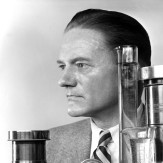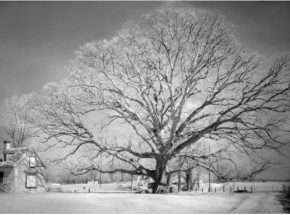

Aubrey Bodine’s photographic career began in 1923 when, as an office boy with the Baltimore Sun newspaper he submitted photographs of the Thomas Viaduct at Relay to the editor of the Sunday paper, and they were published. From first to last Aubrey Bodine was a newspaperman covering all sorts of stories with his camera – news events, famous people, unusual places, and curious activities. This gave him opportunities to travel throughout the mid Atlantic region and learn about it in every tide, wind, weather, and season. Out of this experience came remarkable documentary pictures of farming, oystering, hunting, soap boiling, blacksmithing,
clock making, bricklaying and dozens of other occupations, student nurses, Amish children, pilots of ships and planes, country folk and city folk, wood sheds and cathedrals, wagons and railroad engines, and, in short, anything of interest. His documentary pictures are of the finest quality, often artistic in design and lighting effects beyond the usual standard of newspaper work.
But Bodine’s talent ran deeper than this, and so did his ambition. He submitted photographs to national and international salon competitions and consistently won top honors. Bodine believed that photography could be a creative discipline, and he studied the principles of art at the Maryland Institute College of Art in Baltimore. The camera and the dark room equipment were tools to him like the painter’s brush or the sculptor’s chisel.
Bodine was a romantic pictorialist and this shows in his choice of subjects – the old times and the old things, the beauties of nature, man as an individual, and similar ideas. The pictures are usually quiet in mood, partly because of the subdued tones and partly because of a low tension composition made of open curves and natural perspective.
Not the least of Bodine’s artistic ability was his craftsmanship. He was always experimenting with his tools. Some of his best pictures were literally composed in the viewfinder of the camera. In other cases he worked on the negative with dyes and intensifiers, pencil marking, and even scraping to produce the effect he had in mind. He added clouds photographically, and made other even more elaborate manipulations. Bodine’s rationale for all these technical alterations of the natural scene was simply that, like the painter, he worked from the model and selected those features which suited his sense of mood, proportion and design. The picture was the thing, not the manner of arriving at it. He did not take a picture, he made a picture.
The full text of the biography of A. Aubrey Bodine, A Legend In His Time, written after his death by Harold A. Williams, Bodine’s editor, can be found on this website at Bodine, A Legend In His Time
www.aaubreybodine.com
Image courtesy of A. Aubrey Bodine • Copyright Jennifer B. Bodine
Website
http://www.aaubreybodine.com



